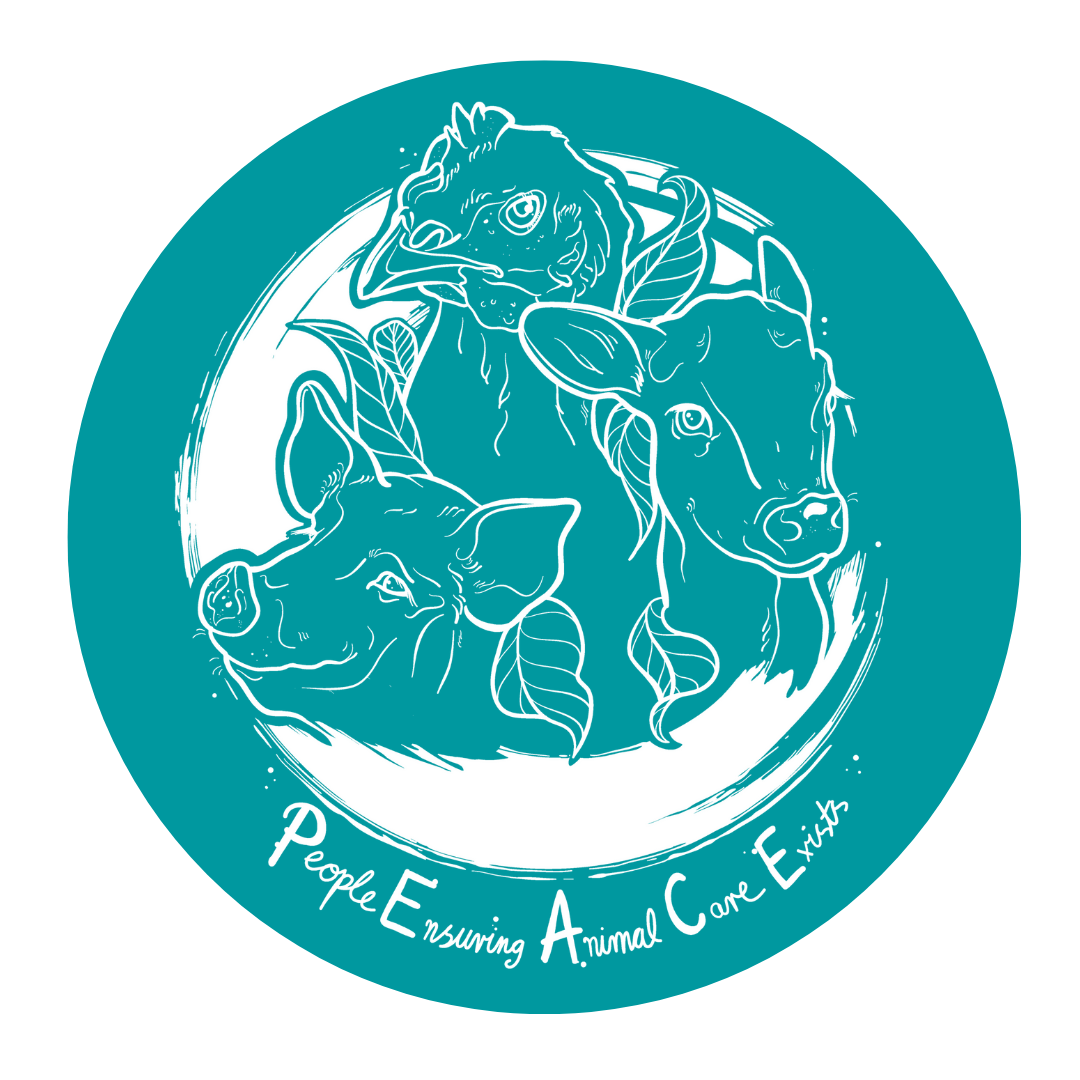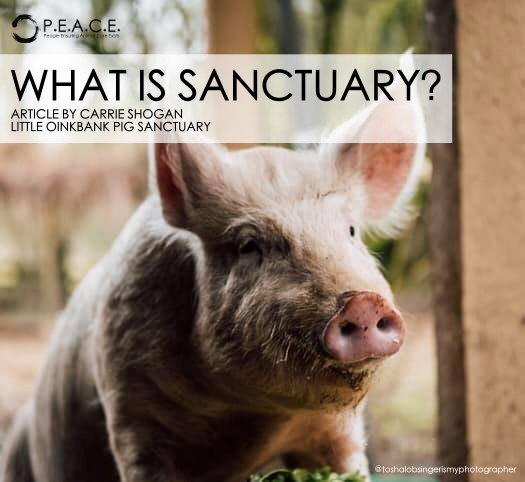
–
sanc·tu·ar·y
/ˈsaNGk(t)SHəˌwerē/
noun
noun: sanctuary; plural noun: sanctuaries
1.1. a place of refuge or safety.
“his sons took sanctuary in the church”
–
My story of sanctuary is not pretty. I did not follow my own advice when becoming a sanctuary. The word never entered my head, let alone the ponderance of its meaning.
I did not volunteer at least once a week, for at least a year at an already-established sanctuary so I could learn the year-round struggles and sacrifices necessary. I did not check my zoning, nor did I ensure I had adequate fencing, structures, equipment, support – physically, emotionally, financially. I was not vegan; I held on to antiquated and selfish notions of animal rights – that they were here to be of use and amusement to us, and as long as I didn’t actively harm them, I had done enough. I certainly had no pie-in-the-sky notions of saving the abused, neglected and mistreated. I was no Saint Francis or Dr. Doolittle wannabe.
I found a couple of pigs on the internet free to a good home (or whatever fate awaited them). Having bought and lost a piglet (sadly and unexpectedly) the year before, I knew I loved pigs. I had also learned that minipigs had it tough when it came to finding forever homes. At least I could provide that. I had an old horse barn, certain fences on the property were okay, and with a little TLC I could bring the old barn tools – pitchforks, shovels, food and water buckets and wheelbarrows – back to life. My husband was less than eager, but he loves me, so he sighed and began constructing stalls.
Life sometimes has other plans. The mother pig and her two juvenile daughters we took on with little thought had come from a breeder dumping her “stock”, and our three pigs each gave birth within two months of their arrival. Suddenly we found ourselves with 18 pigs.
Still, no worries. We were looking for a way to put the property to use and make some extra cash. We could sell the piglets as pets – to good, forever homes only. We would be the exception. The only “responsible” breeders around.
I advertised, got answers, offers. I became increasingly uneasy and found every excuse I could to not sell a piglet. We watched Momma – the senior pig and herd leader – become frantic and aggressive every time we came near. We watched her teach her babies to fear us, to run from us (she was the only one of the three to do this, as the other two had never been bred before). We began advertising in vegan-only community groups. Surely the piglets would be safe then. You can imagine how that went. You may remember it, may even have provided a helpful comment or two. It certainly helped break apart the already-crumbling cognitive dissonance in which I had wrapped myself.
But the real credit must be given to Momma the pig. She showed me through her desperation and despair that I would steal yet another baby from her – as they had all been stolen before – that she was no different than me. And that her love for her children was just as powerful, just as valid as mine.
Thus began my long and accidental journey to Sanctuary. Once I realized and accepted the responsibility we had undertaken, I knew we would have to do it right. I’ve spoken before of the lucky alignment of stars I live under – of my extensive background of stable management, access to excellent veterinary care and knowledge of basic farm animal behavior and first aid, and of course, the extensive support of my partner and family. By chance, I already ticked many of the “Sanctuary” boxes. I have spoken at length to many other sanctuary operators and learned much from them, albeit after the fact, and I am still open to learning from them. I have also learned some terrible lessons through trial-and-error. It is the nature of the beast that we cannot prepare for every little thing, but there are many things within our power to control and we have an obligation to take charge of them.
Suddenly everything was set aside for the animals. There were no more holidays, no more sick days, no more mental health days. I had to now ensure the animals had excellent medical, physical, and nutritional care, and not just that their environment was safe and secure, but also peaceful and enriching. I needed to ensure that we developed a budget and that we could plan and pay for not just the day-to-day needs, but for emergencies as well. We needed to establish our limits, where guests and volunteers are concerned. As the voice of the animals in our care, we needed to ensure that their needs came first and that they are never exploited.
We have been sick. We have been injured. We have felt financial strain. But we took on a duty of care that is for their entire lives. We have had to be resourceful, necessity being the mother of invention. We have had to recognize our own empty wells and learn to say hard NOs; to guests, volunteers, and most importantly, to say NO to taking on more animals if it means that, while it might save an immediate life, it would diminish the quality of care of those already here. This may have been the hardest NO to learn.
I must walk a fine line with veterinary care and recognize that the vast experience needed to give our animals the kind of care they need and deserve usually comes from industry vets. I must balance their knowledge with my heart and stand up (when necessary) when “standard industry practices” are not necessarily in the animals’ best interests, and I must have the planning and know-how to know when to do so.
I spoke to several experienced sanctuary operators and animal rescuers while writing this, and my wise friend Michelle from A Home for Hooves Sanctuary on Vancouver Island made a very thoughtful observation: As a Sanctuary Operator I represent ALL sanctuaries. Whatever our mandate or method, we are, in the public perception, as one. If I behave in a manner unprofessional, if my words or actions bring unwanted attention to the animals, if I behave in a way that does not put the animals first, I bring disrepute to all sanctuaries. I have always maintained that while we are all feeding from the same volunteer and donor trough, we are stronger together and we must strive to elevate each other through our own actions and, when necessary, inactions.
Sanctuary is enough. I do not need to put on a superhero cape with my Insta-story recording live. I already learned the hard truth that I can’t save them all. In fact, to attempt to do so may diminish the care and security I have worked so hard to foster for those already in my charge. The animals’ job is simple: Exist. In so doing they enable me to educate so that hopefully one day soon, Sanctuary is no longer necessary.
In the meantime, we have come back to answer our original question: WHAT IS SANCTUARY?
When it comes down to it: I AM.
Not my barn, not my fences, not the name on my social media pages. My name does not matter. Sanctuary is the vow I made when I looked in Momma’s beautiful eyes and finally – FINALLY – understood what she had been screaming: Keep us safe. At all costs, and above all else. Sanctuary is me. And for them, it is enough.
–

